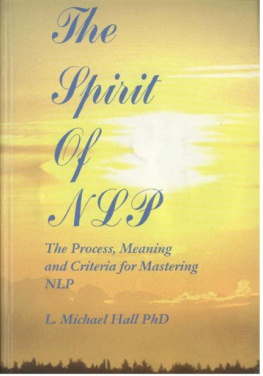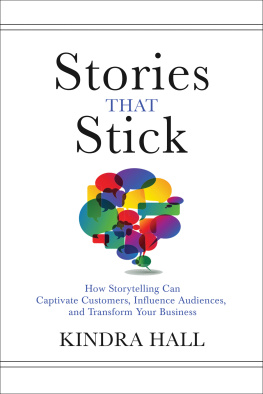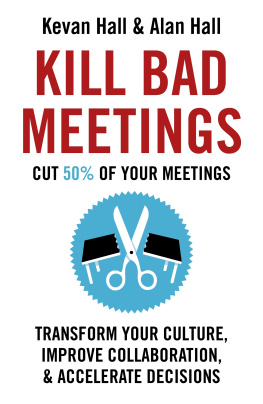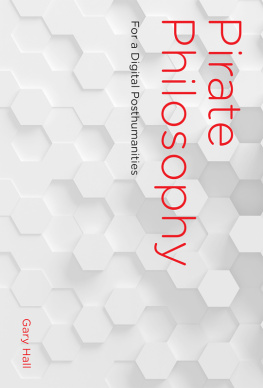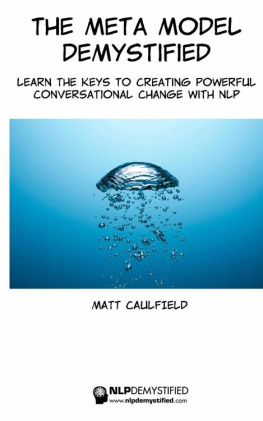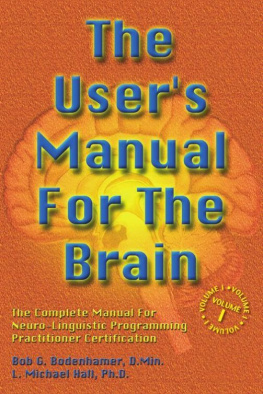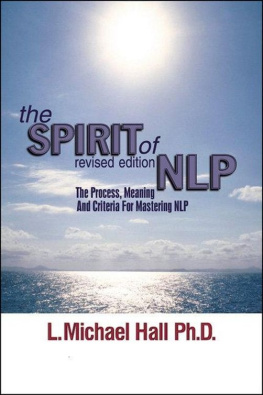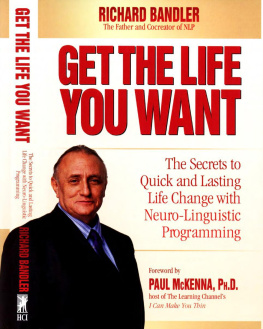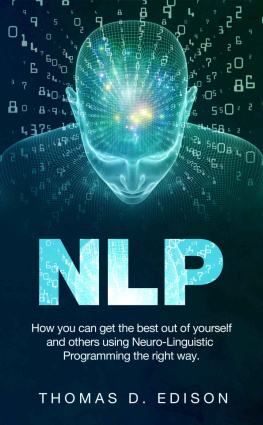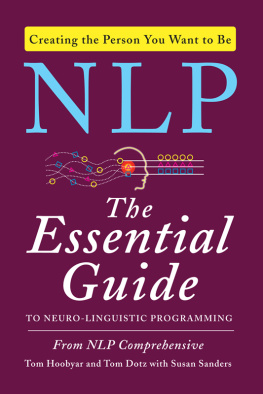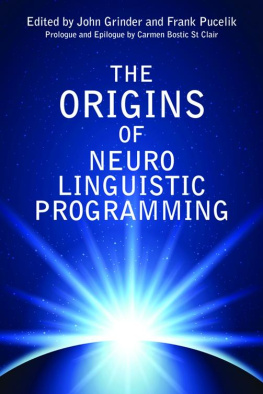The Process, Meaning and Criteria for Mastering NLP
L. Michael Hall PhD
First Published in the UK by
The Anglo American Book Company Ltd
Crown Buildings
Bancyfelin
Carmarthen
Wales
Copyright 1996 by Michael Hall
The rights of Michael Hall to be identified as the author of this work are asserted in accordance with the Copyright, Designs and Patents Act 1988.
British Library of Cataloguing in Publication Data
A Catalogue record for this book is available from the British Library.
All rights reserved. No part of this publication may be reproduced, stored in a retrieval system, or transmitted in any form or by any means, electronic, mechanical, photocopying, recording and/or otherwise without the prior permission of the publishers. This book may not be lent, resold, hired out or otherwise disposed of by way of trade in any form, binding or cover other than that in which it is published, without the prior consent of the publishers.
ISBN 1899836047
To Richard Dandier without whom this hook could not have been written, and the person who exemplifies the spirit of NLP.
Printed and bound in Wales
Contents
Page |
1. A propulsion system | |
2. Moving to the master practitioner level | |
3. Going meta to this mental mapping process | |
4. Presuppositions and language | |
5. Operational levels ol the me la model | |
6. The pattern of deletions, gencralizations.dlstorttons |
and presuppositions | |
7. Operational levels of Ihe meta-model | |
8. Causation words | |
9. How belief relates lo experience | |
10. Relationship between values and experience | |
11. Continuum of sounds | |
Eliciting and recognizing submodalities | |
Meta-programs sorting grid | |
List of Charts
Page
Introduction vti - xx
PART I: PROGRAMMING
Ch. 1: Developing an Internal Propulsion System 3
CIx.2: Learning Trance 41
Ch.3: Developing a Deeper Understanding/Appreciation
of the Language. Structure. States of Trance 57
PART : LINGUISTICS
Ch. 4: Mastering NLP Linguistics 71
Ch 5: Master Level Persuasive Re-Framing 115
PART : NEUROLOGY
Ch. 6: Masteriixg The Neurology OJNIJ* 139
Ch. 7: The Wild And Wonderful World Of Submodalities 161
Ch. 8: Tracking Down Wh^re Brains Go 169
Ch. 9: Visiting More Exotic And Empowering States 189
Ch. 0: Tfte NLP Meta Programs 203
Ch. II: Kinesthetic Time-Lines 257
Appendix A : Why The Use Of EPrime In Writing This Book? 269
Appendix : A Domain OJ Logical Levels: Self-Reflexiveness
In Human States OJ Consciousness 273
Appendix : Useful Addresses 291
Bibliography 295
THE SPIRIT OF NLP The Meaning. Process. & Criteria For Mastering NLP
INTRODUCTION
What represents the spirit of NLP? What distinguishes a practitioner of this art from a master practitioner"? Wherein He the distinctive meaning and criteria involved in mastering the NLP model? What process enables one to master il? I have written the following, based first upon my own Master Practitioner Training and Trainer's Trainer under Richard Bandler, and then upon my own experiences and readings over the years wilh NLP as a psychotherapist and trainer, to answer these questions.
As the years pass from my original training with Richard Bandler. my sense of him as someone who truly manifests the spirit of NIJ* has grown. Accordingly. I have based much of the following upon this opinion. To know Richard Handler makes one aware that he has served this many years as the creative genius behind NLP. To get to know him also beyond that rough exterior that he can sometimes present introduces one to his spirit of passion in 'going for it" and his curiosity for the possible. And this very spirit functions in a foundational way to make NLP dramatic and dynamic.
The NLP paradigm, as a communication and behavioural model, arose partly, it seems to me. as those men and women who later became the co-founders and developers of NLP began to translate Bandler. Yes. Bandler and Grinder originally set out in model Virginia Satir. Fritz Perls, and Milton Eriekson. etc. And yet as they did. they did so because of Richard's genius in so quickly and unconsciously modeling these experts with astonishing ease and speed. After he surprised himself by modeling Satir and Perls, he and John set out to pull apart
the component pieces of neurology and language to understand how this "magic" occurred and how they could enable others lo Install the same excellence in themselves.
Richard Bandler's spirit, then, with his wild and wonderful ideas, his gruff style, and his unpredictable curiosity lies at the heart of this revolutionary technology of human resourcefulness. NLP reflects and represents his genius of modeling.
1 first picked up this conviction through reading all of the "classic" seminar books that Steve and Connirae Andreas edited. From those books. 1 decided to do my NLP training with Richard Handler himself. During my 1989 Master Practitioner training in San Diego. I took extensive notes which 1 later published with the approval of (the then) "NLP Prodxiets and Promotions" organization for the participants al the training.
In 1990. Richard asked me lo create another set of notes for his Trainers Training", which I did. From there. Richard asked me to transcribe his work with "Applied Neuro Dynamics' which he gave at a London Seminar as well as his hypnosis work. This later became the basis for his book. "Time for A Change'. During that time 1 also worked with Richard in producing a Directory of the NLP Society of Handler and Associates.
In the years since that time. I have not only continued to use and develop NLP as part of my psychotherapeutic practice as a cognitive therapist. I have conducted numerous NLP practitioner and master practitioner trainings. More recently. I have researched the historical roots of NLP in Alfred /ybski and Gregory Bateson. Some of that material has been published as a series in "Anchor Point". 1 also did a series on The Almost Inventors of NLP". and then began creating integrations of NLP with several other psychologies such as Reality Therapy. Adlcrian psychology, etc.
This work represents an expansion of my original notes by several hundred pages. This text focuses primarily on conveying the spirt of NLP, At the same time. I think that it offers, to a large degree, the genius, attitude, and passion of Richard Bandler as the founder of this domain. Now it seems to me that in identifying that spirit, specifying Its components and finding Its strategy offers a significant contribution to the ongoing development of NLP. Wouldn't you like lo have the strategy that Bandler used in coming up with NLP In the first place? And. of course, the NLP model Itself says that wc all inevitably keep manifesting our states and strategies in our ongoing communications anyway. Docs it not make sense then that Richard Bandler would construct, design, and present his trainings in a way that would manifest his own "spirit" or strat which made this field possible?
I have started with these understandings and assumptions as I pul this text together. Accordingly, you will find in these pages most of the essential academic and Informational data within the NLP Master Practitioner track. And you will find more. You will find within, behind, and beyond the words of the text what I believe serves as the spirit of NLP behind thai information.
Next page
